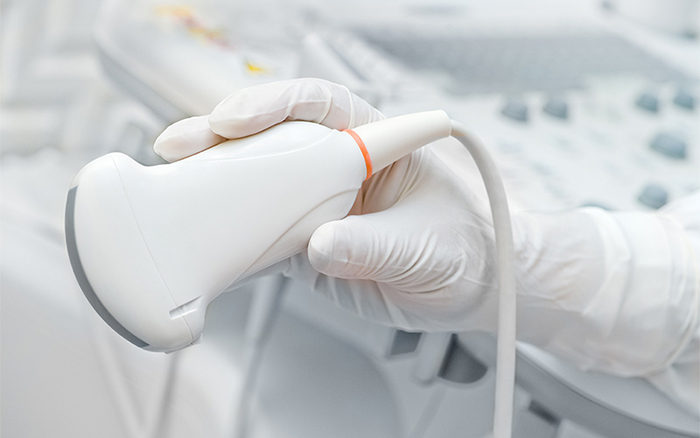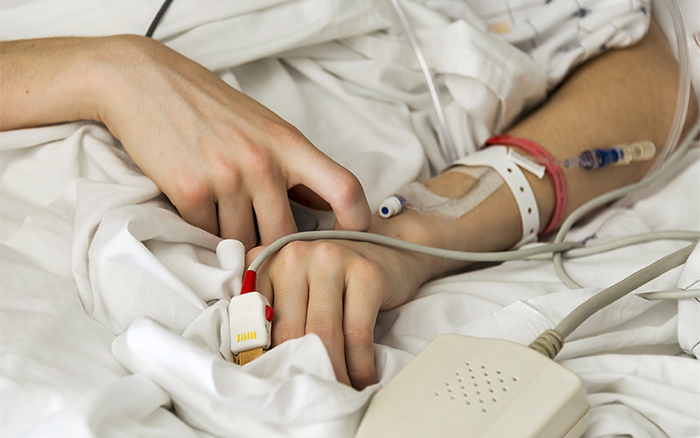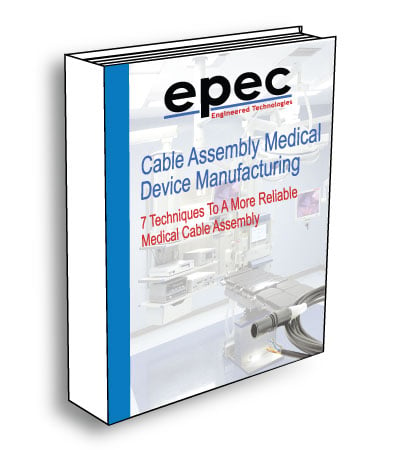Using Silicone Jacketed Cables in Medical Applications
By Steven J. Goodman, User Interface & Cable Assembly Product Manager
Epec Engineered Technologies
The jacket is the outermost layer of a cable, and its primary function is to protect and electrically insulate the internal conductor of the cable. The jacket is crucial in terms of safeguarding everything contained inside from not only mechanical issues, but also performance issues arising from moisture, heat, open flames, chemicals, UV exposure, and more.
Note that a cable's jacket should not be confused with insulation, which is a thin coating of material that is usually placed directly onto the bare wires. Both are designed to protect the cables in question, but they have different uses and different ways of accomplishing that goal.
What are Silicone Jacketed Cables?
Silicone jacketed cables (Figure 1), as their name suggests, are ones that are designed using synthetic polymers with a chemical structure that is based on chains of alternating silicon and oxygen atoms. During the manufacturing process, large volumes of quartz sand are heated to temperatures that can reach as high as 1,800°C. Pure, isolated silicon is derived from this, and it is then cooled and ground into a fine powder.
![]()
Figure 1: Example of a silicone jacketed cable.
After combining that powder with methyl chlorine and heating it to trigger a chemical reaction, it is then mixed with additional industrial chemicals materials like dimethyldichlorosilane before everything is separated once again. After additional mixtures that are then heated to very precise temperatures, and following a lengthy distillation process, hydrochloric acid is then used to condense everything into polydimethylsiloxane. This contains the siloxane bond, which is the backbone of the silicone material that will then be used to manufacture raw silicone materials.
Now in a raw form, silicone is mixed and extruded around the cable per the specific manufacturing process involved. For many setups, a center conductor or jacketed wire is fed through a tool at high speeds where heated and viscous silicone wraps the cable and cools into the final extruded shape. This completed cable is then tested for continuity and for any irregularities in the outer jacket. What is produced from this highly complex process is a normal looking cable with exceptional flexibility, temperature resilience, and even biocompatibility.
Silicone cable jackets are usually selected because there is a unique design challenge. Some environments require superior flexibility, which offers ease-of-use advantages as well as long-term flex life and resilience to fatigue. This highly flexible jack also provides a tight minimum bend radius, allowing for the cable to be fed through narrow openings and corners. Silicone jackets are also chosen for extreme temperature applications since silicone is stable across a wide range of temperatures.
The Common Uses for Silicone Jacketed Cables
Thanks not only to their inherent flexibility, their superior UV resistance, and their reliability under even extreme temperature conditions, silicone jacketed cables are commonly used across a wide array of different industries. They are commonly used for the purposes of serving as the insulation material for some residential and industrial wiring applications.
Silicone jackets also regularly used for insulating and bundling aircraft and aerospace wiring harnesses for those same reasons, as well as the fact that cables in these environments are often subjected to the particularly harsh conditions that silicone jacketed cables are perfect for. Parts in this context are often exposed to both extreme heat and moisture, both qualities that silicone jacketed cables can stand up against in a way that alternative options cannot.
As stated, silicone jacketed cables are popular in part due to their wide temperature range. They can be subjected to temperatures as low as -67°F and up to 400°F.
There are also a few additional benefits of silicone jacketed cables worth noting, all of which make them an ideal solution for many industries. They offer excellent aging resistance, for example, even under extreme conditions. This makes them a perfect solution for projects that require accelerated aging tests and a guarantee the cables will not break down over time.
Silicone Jacketed Cables in the Medical Industry: Breaking Things Down
To say that the stakes are high in terms of high reliability performance of cable assemblies used in medical devices (Figure 2) is a bit of an understatement. When you are talking about a piece of equipment used to monitor the fragile health of a patient, or an implantable device that is intended to keep someone alive, there is no room for error. It is no surprise that silicone jacketed cables are used in many different applications throughout the medical industry, especially for Class 1, Class 2, and Class 3 medical devices.

Figure 2: Cable assembly used in medical device.
These cables are commonly employed in applications including robotic systems, sensors, and cables that may come into direct contact with a patient (Figure 3). When designed properly, silicone jacketed ribbon cables can withstand millions of flex cycles without performance degradation. This high reliability performance is required for multi-axis motion systems, robotic arms, and many of the moving parts within advanced imaging systems.

Figure 3: Example of cables coming into direct contact with a patient.
Silicone jacketed cables are also used to support several types of handheld devices that medical professionals have come to depend on. One of the most important concerns for items that come into direct patient contact is sterilization. Electronic medical devices used in healthcare settings must be sterilized after every procedure. More often than not, this requires the use of an autoclave, which is a particular type of machine used to steam and sterilize equipment and other objects. Due to the extreme temperatures present inside the autoclave, any bacteria, viruses, fungi, and spores that may be on the items in question are inactivated. Autoclaves are found in a wide array of different medical environments from hospitals to laboratories to any other place where the sterility of equipment is of the utmost importance. Additionally, silicone jacketed cables are also subjected to frequent cleaning and disinfection procedures after they go through the autoclave sterilization process (often with harsh chemicals) to make sure that there is no change of pathogens remaining.
Silicone jacketed cables emerge as one of few material choices for these situations as their superior chemical resistance and resilience across wide range of temperatures make them more than capable of withstanding repeated cleaning, sterilization, and disinfection. If one-time use is a requirement, silicone jacketed cables can survive the initial sterilization and have become popular in both "one-time use" and reusable medical items.
Although silicone performs exceptionally in extreme temperatures and high-flex applications, the most important benefit of silicone is the biocompatible nature of the material. Most silicone is engineered and produced to comply with both Food and Drug Administration (FDA) and ISO 10993 biocompatibility standards. This means that silicone is not harmful to living tissue, which is particularly important when you are designing a product that will eventually be implanted inside the human body. Silicone jacketing is a great option for any cable applications that demand physical contact with human skin and carry a biocompatibility designation.
Start Your Custom Medical Cable Project with Silicone Materials
It is clear there are numerous benefits to using silicone as a jacket material in your custom medical cable assembly. These include favorable temperature resilience, high flexibility and mechanical properties, and FDA-approved biocompatibility. Silicone does not support bacterial or fungal growth, and it will not cause the corrosion or staining of surrounding materials. Silicone carries an agency recognized biocompatibility allowing for its use across countless medical and human contact applications. It’s so benign to humans that adults with extremely sensitive skin are using biocompatible silicone wedding bands in lieu of the traditional gold, white gold, and other metal options. As shown in silicone rubber keypads, grommets, seals, and other everyday items, it is inexpensive and practical enough to be used across various industries.
Looking For a Reliable Cable Supplier?
With working on countless medical applications, our team of engineering can help you to design and manufacture cable assemblies that hold up to environments encountered in medical settings.
Request a Quote Request Design Support


